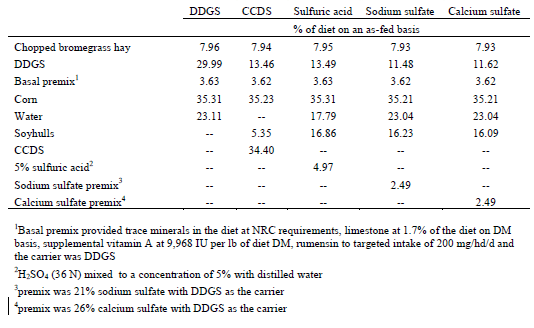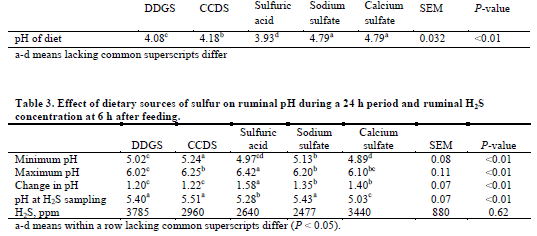



Dietary Sulfur on Rumen pH & Hydrogen Sulfide Gas Concentration
Using different sources of sulfur in cattle diets does not change the potential for sulfur toxicity, according to research carried out by the University of Iowa.Summary and Implications
The objective of this experiment was to compare the effects of 5 commonly used sulfur (S) sources in research trials: dry distillers grains with solubles (DDGS), condensed distillers solubles (CCDS), sulfuric acid, sodium sulfate, and calcium sulfate, on ruminal pH and hydrogen sulfide (H2S) concentrations. While diet and ruminal pH did differ among the treatments, there was no difference among S sources in ruminal H2S concentrations measured 6 hours post-feeding. These data suggest that there is no difference in the potential for S toxicity among the different S sources used in this study.
Introduction
Many universities have conducted research trials on the effects of dietary S on the potential for toxicity in cattle; however, different sources of dietary S have been used. Therefore, the objective of this study was to compare the effects of different S sources on ruminal pH and H2S concentrations, to determine if results from research studies using different S sources can be compared.
Materials and Methods
To determine the effect of the 5 commonly used S sources on rumen pH and H2S concentrations 5 fistulated beef steers (1612 ± 85 lbs) were randomly assigned to treatments in a 5×5 Latin Square Design, with 5 treatments and 5 fourteen day periods. All diets were formulated to contain 45% corn, 10% chopped hay, and 0.5% sulfur on a DM basis. The DDGS diet contained DDGS at 40% of diet DM while the other diets contained DDGS at 21% of diet DM. The 5 sources of S were: sodium sulfate, calcium sulfate, condensed corn distillers solubles (CCDS), sulfuric acid, and dried distillers grains (DDGS). The S source was added to the diet to contribute 0.19% S (the amount of S contributed by the DDGS in the DDGS diet that was not from the corn portion of the DDGS; i.e. the S from the sulfuric acid used during ethanol production). Soyhulls were added to make up the balance of the DM in the non-DDGS diets. Water was added to the non-CCDS diets to equalize moisture across diets at 69% dry matter (Table 1).
Steers were limit fed at 1.3% of their body weight, and the amount to feed was calculated after steers were weighed on day one of each period. The feed amount was the same from day 1 to day 14 of that period. Individual steer diets were weighed and mixed daily. Indwelling rumen boluses designed to measure rumen pH were placed in each steer prior to initiation of the trial.
Diet pH was measured on day 1 of each period. Animal feed refusals were recorded and sampled daily. On day 14 of each period animal feed refusals and H2S gas concentrations were collected at 6 hours post feeding. Data were analyzed using Proc Mixed in SAS (SAS Inst. Inc., Cary, NC).
Results and Discussions
As designed, there was no difference in S concentration (0.496%), or dry matter intake (20.9 lb/hd/d) between treatments. Diet pH (P < 0.01; Table 2) and ruminal pH (P < 0.01; Table 3) differed among S sources. Steers receiving the sulfuric acid diet exhibited the greatest change in rumen pH over a 24 hour period as they experienced the greatest maximum rumen pH values and also one of the lowest rumen pH values (Table 3). However, there was no difference (P = 0.62) among S sources in ruminal H2S measured 6 hours post-feeding (Table 3). Though there were differences in rumen pH among dietary S treatments all treatments resulted in rumen pH values of less than 5.5 for at least some period of the day, suggesting that in all treatments approximately 95% of the sulfide produced by sulfate reducing bacteria would be converted to H2S in this pH dependent process. These data suggest that when equal amounts of S are consumed by cattle, regardless of S source, similar concentrations of H2S are produced.
Composition of the Diets on an as-fed Basis.

Effect of Dietary Sources of Sulfur on pH of the Diet.

April 2012


